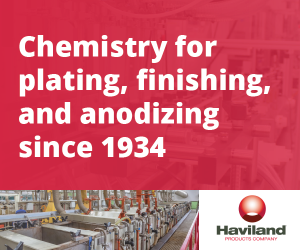PLATING
Narrow by Plating Product Category
- Acid Salts
- Acids
- Air-Sampling Equipment (In-Plant Environment)
- Aluminum Etchants & Deoxidizers
- Ammeters & Voltmeters
- Ampere-Hour Meters
- Analytical Equipment, Atomic Absorption, Spectrophotometric
- Analytical Equipment, Automatic Solution Titration
- Analytical Equipment, Ion Chromatography
- Analytical Equipment, Photometric
- Analytical Equipment, Polarographic
- Analytical Equipment, Specific Ion
- Analytical Equipment, X-ray Fluorescence
- Anode Bags
- Anode Bars, Baskets, Hooks
- Anodes, Brass & Bronze
- Anodes, Cadmium
- Anodes, Carbon
- Anodes, Cobalt, Nickel/Cobalt
- Anodes, Copper
- Anodes, Indium
- Anodes, Insoluble: Ceramic & Metal Oxide
- Anodes, Lead
- Anodes, Magnesium
- Anodes, Nickel
- Anodes, Platinum and/or Palladium-clad
- Anodes, Silver
- Anodes, Steel & Iron
- Anodes, Tin
- Anodes, Tin-Lead
- Anodes, Tin-Zinc
- Anodes, Titanium
- Anodes, Zinc
- Anodizing Processes & Equipment, Aluminum Hardcoat
- Anodizing Processes, Aluminum
- Anodizing Rack Components
- Anodizing Sealants
- Anti-Mist Chemical Additives
- Antiquing Solutions
- Associations, Tradeshows & Professional Groups
- Balls, Floating Plastic (for Solution Heat Retention and/or Fume Suppression)
- Barrel Finishing Equipment
- Barrel Plating Equipment
- Barrel Plating Equipment Repair
- Barrel Plating Media
- Baskets, Dipping, Pickling, Handling
- Blackening Processes, Solutions
- Blowers, Air (for Push-Pull Ventilation)
- Blowers, Air (for Solution Agitation)
- Boilers
- Bright Dips
- Brightener Feeders, Automatic
- Brush Plating Equipment, Solutions & Supplies
- Carbon, Activated
- Carboy Pumps
- Cathode Rod Agitators
- Chelating Agents
- Chemical Transporting Equipment
- Chillers
- Chromate Conversion Coatings
- Chrome-Free Final Rinses (for Paint Pretreatment)
- Clamps, Anodizing, Plating & Powder Coating
- Coatings Etchant Resistant
- Coils, Liquid Heating & Cooling
- Computer Control Systems for Finishing Processes
- Computer Software for Finishers
- Consultants, Independent, Aluminum Finishing
- Consultants, Independent, Electroplating and/or Electroless Plating
- Controls, Alkalinity Regulation
- Controls, Electroless Plating
- Controls, Electroplating
- Controls, Gas/Vapor Concentration
- Controls, Liquid Level
- Controls, pH
- Controls, Rinse Tank Concentration
- Controls, Solution Conductivity
- Controls, Temperature
- Conveyor Belts
- Conveyor Cleaning Equipment
- Conveyor Loading/Unloading Equipment, Automatic
- Conveyor Lubricators
- Conveyors, Belt
- Conveyors, Chain-on-Edge Spindle-type
- Conveyors, Flat Pallet
- Conveyors, Inverted Power-and-Free
- Conveyors, Magnetic Belt
- Conveyors, Overhead Chain
- Conveyors, Overhead Power-and-Free
- Conveyors, Overhead Traveling Hoist
- Conveyors, Wicket
- Cooling Equipment for Plating & Anodizing Solutions
- Courses in Electronics Finishing
- Courses in Electroplating
- Courses in Electroplating, Correspondence
- Current Controls
- Current-Density Meters
- Danglers & Cathode Contacts, Barrel Plating
- Drum Liners, Rubber, Plastic
- Drum Pumps
- Drum Warmers
- Drum-Handling Equipment, Accessories
- Dryers, Centrifugal
- Dryers, Compressed Air
- Dryers, Rotary, Spiral
- Dryers, Solvent
- Dyes, Anodizing
- Electrical Connectors, Chemical & Corrosion Resistant
- Electroforming Equipment
- Electrolytic Coloring Processes for Anodized Aluminum
- EMI/RFI Shielding Finishes
- Environmental Test Chambers
- Equipment Engineering & Installation Services
- Etchant-Recovery & Recycling Equipment
- Etching Machines
- Filter Aids
- Filters, Breathing Air
- Flocculants, Polyelectrolytes
- Flooring, Chemical-Resistant
- Flow Meters, Liquid
- Fluxes, Tinning & Soldering
- Foam-Control Chemical Additives
- Galvanizing Equipment, Supplies
- Gloves, Work
- Hardcoatings, Clear, Scratch Resistant
- Heaters, Immersion
- Heaters, Liquid, On-Demand
- Heaters, Steam/Hot Water
- Hoists, Traveling: Automatically Controlled
- Hoists, Traveling: Manually Controlled
- Humidity Cabinets
- Infrared Heaters, Electric
- Inhibitors, Acid Pickling
- Inks, Metal Color-Coding
- Inks, Metal Decorating
- Laboratory Supplies, Plating
- Lacquer
- Lacquer, Water Displacing
- Magnets, Tank
- Masking Caps, Discs, Plugs
- Masks, Plating
- Mechanical Galvanizing Supplies
- Mechanical Plating Equipment
- Mechanical Plating Supplies
- Metal Tubing
- Metal-Identification Instruments, Kits
- Nickel Activators
- Noise-Control Enclosures, Devices
- Oxide Finishes, Colored
- Panels, Paint & Plating Testing
- Passivation Processes
- Periodic-Reverse Equipment, Current Interrupters
- pH Electrodes
- pH Meters
- pH Papers
- Photo-Sensitive Resists
- Pickling Solutions
- Pipe & Fittings, Chemical Resistant
- Plating & Anodizing Equipment
- Plating Activators, All Metals
- Plating Conveyors
- Plating Equipment, Continuous (Wire & Strip)
- Plating Processes
- Plating Processes for Aluminum
- Plating Processes for Magnesium
- Plating Processes for Plastics
- Plating Processes for Printed Circuits
- Plating Processes, Alloy: Chromium Substitute
- Plating Processes, Brass or Bronze
- Plating Processes, Cadmium
- Plating Processes, Chromium
- Plating Processes, Chromium, Colored
- Plating Processes, Chromium, Trivalent
- Plating Processes, Cobalt, Cobalt Alloy
- Plating Processes, Copper
- Plating Processes, Copper, Electroless
- Plating Processes, Fluoborate
- Plating Processes, Gold
- Plating Processes, Gold, Electroless
- Plating Processes, Indium
- Plating Processes, Iron
- Plating Processes, Lead
- Plating Processes, Nickel
- Plating Processes, Nickel Sulfamate
- Plating Processes, Nickel, Colored
- Plating Processes, Nickel, Electroless
- Plating Processes, Nickel, Satin Finish
- Plating Processes, Nickel-Iron
- Plating Processes, Palladium
- Plating Processes, Palladium, Electroless
- Plating Processes, Particle Co-Deposition
- Plating Processes, Platinum
- Plating Processes, Rhenium, Ruthenium
- Plating Processes, Rhodium
- Plating Processes, Rhodium, Electroless
- Plating Processes, Silver
- Plating Processes, Silver, Electroless
- Plating Processes, Tin
- Plating Processes, Tin, Electroless
- Plating Processes, Tin-Lead
- Plating Processes, Tin-Nickel
- Plating Processes, Tin-Zinc
- Plating Processes, Zinc
- Plating Processes, Zinc-Cobalt
- Plating Processes, Zinc-Iron
- Plating Processes, Zinc-Nickel
- Plating Rack Coatings
- Plating Testing Equipment
- Plating Timers
- Printed Circuit Board Etchants
- Printed Circuit Board Processing Chemicals
- Printed Circuit Board Processing Equipment
- Programmable Controllers
- Pulse Plating Power Supplies
- Pumps for Chemical Service
- Pumps, Chemical Additive
- Rack Trucks
- Racking/Unracking Machines
- Racks, Plating, Painting & Anodizing
- Rectifier Rebuilding & Repair
- Rectifiers
- Refiners & Reclaimers, Metals
- Resins, Ion Exchange
- Safety Equipment & Materials, Personal
- Selective Plating Machines
- Shop Management Software & Systems
- Sodium Hypophosphite
- Software for Finishing
- Spectrophotometers
- Stop-Off Coatings, Waxes
- Surface Roughness Measuring Devices
- Tank Covers
- Tank Linings, Tumbling Barrel Linings
- Tanks, Chemical Shipping
- Tanks, Metal
- Tanks, Plastic
- Temperature Indicators
- Test Cells, Plating Solution
- Testing Equipment, Abrasion Resistance
- Testing Equipment, Accelerated Weathering
- Testing Equipment, Adhesion
- Testing Equipment, Electrochemical Corrosion
- Testing Equipment, Electroplate Stress
- Testing Equipment, Electroplate Thickness: In-Bath Monitoring
- Testing Equipment, Hull Cell
- Testing Equipment, Impact Resistance
- Testing Equipment, Rectifier Ripple
- Testing Equipment, Salt Spray
- Testing Equipment, Slip & Friction
- Testing Equipment, Solution Concentration
- Testing Equipment, Surface Tension
- Testing Equipment, Thermal Cycling
- Testing Equipment, Thickness of Coating
- Testing Laboratories, independent, electroplating
- Testing Service, Accelerated Weathering
- Thermometers, Pyrometers
- Titanium Racks, baskets
- Used Equipment
- Vacuum-Deposition Equipment, Supplies
- Valves
- Water-Softening Equipment
- Waxes
FAQ: Plating
Why isn’t my brush-plated deposit uniformly distributed?
The key to uniform thickness distribution is uniform current distribution. Fundamental laws of electrochemistry (i.e. current distribution) do not always allow for a uniform deposit. Direct current always seeks the path of least resistance from the anode to the cathode (substrate/workpiece). As a result, paths of least resistance, such as sharp edges or protrusions, will receive a heavier deposit, while areas such as internal corners/radii receive a significantly less amount of deposit.
One consideration for deposit uniformity is ensuring an even distribution of plating solution over the area being plated. For best results, the plating solution should be pumped to the work area through the plating tool and uniformly distributed over the work area. An uneven distribution of fresh solution over the work area will result in an uneven deposit thickness.
In order to achieve uniform deposit thickness, a well-designed, properly-used plating tool is critical.
Other factors to consider:
- The thicker the deposit, the more difficult to plate a tight tolerance.
- It is easier to accurately plate on a small area than a large area.
- It is easier to hold tight tolerances on simple shapes with no interruptions than complex shapes or shapes with interruptions or a large percentage of high current density edge areas.
- Mechanical movement of the part or the anode is going to produce more consistent results than hand movement.
- It is easier to accurately plate a low thickness on a small area than to plate high thickness on a large area.
How well does a brush-plated deposit adhere to the base metal?
A good non-destructive test for evaluating the adhesion of electroplated deposits, unfortunately, is not available. All good tests at least partially destroy some of the deposit on the workpiece, even though there is excellent adhesion. This requires a reliance on some indirect and less-than-ideal tests. It has been found, however, that use of some or all of the following five test procedures assures, in a majority of the cases, adhesion sufficient to meet the demands of the application:
- Chisel, Knife and Scratch Test
- Grind and Saw Tests
- Bend Tests
- Tape Test (nondestructive)
- Visual Test (nondestructive)
Read Plating Clinic: Adhesion of Brush Plated Deposits for rundowns on each test.
My cleaners are not lasting nearly as long as they should. What can I do to lengthen the life of my cleaner bath?
There are a few things that will affect the life of your cleaner baths. The first concerns the condition of parts that you are putting into the bath. If the parts are dripping with oil/grime, your cleaner isn’t going to last very long because it will have a lot to clean up. This is easily fixed by lowering the amount of oil used to ship or manufacture the parts. Additionally, depending on the type of cleaner you are using, adding a weir to your cleaner tank may help lengthen bath life by removing oil from the top of the bath.
The quality of the water being used can also affect the cleaner bath life. Each of the broad categories of water (hard, soft and purified water) have different properties that may affect the bath life. Baths with purified water will last the longest, due to the fact that nearly all of the dissolved minerals have been removed, leaving pure, clean water.
The type of cleaner may also affect the life of a cleaner bath, though this will vary case-by-case. There are many types of oils and compounds used to manufacture parts, and for every oil and buffing compound, there is a surfactant or soap that will clean it. For instance, paraffinic oils can be very difficult to clean.
Talk with the oil supplier and cleaner supplier to find the best solution and check at what temperature the cleaner should run—oftentimes, cleaners will have a range at which that they can run.
(Source: Plating Clinic: Cleaner Bath Life)
What is the difference between non-dyed vs. dyed acid copper technologies?
The debate over dyed versus non-dyed chemistry is ongoing. The primary difference between the two systems is the characterization of the chosen leveler. Levelers that have color (purple, blue, yellow, green, etc.) tend to be classified as “dyes.” Non-dye levelers tend to produce additives that are colorless or slightly yellow. Whether dyed or non-dyed, virtually all levelers are quaternary amine compounds. Brighteners and carriers are consistent between the two systems and from supplier to supplier. What does change is the chosen leveler and the ratio of brightener components to leveler components.
We are trying to plate small plastic parts that float in the plating solution. The parts have an electroless copper coat and must be plated with nickel and gold. We would like to barrel plate the parts rather than rack them. Do you have any suggestions as to how this can be done?
- Use a portable barrel that has button contacts instead of dangler contacts.
- Completely submerge the barrel so all the air is removed. The floating parts will make contact with the buttons at the top of the barrel.
- Using a slow rotation speed, copper plate the parts until they sink in the barrel and maintain contact with the buttons in the bottom of the barrel.
- Rinse thoroughly and then transfer to the nickel plating solution.
(Source: Plating Floating Plastic Parts)
Get Listed!
Thousands of people visit this Supplier Guide every day to source equipment and materials. Get in front of them with a free company profile.






